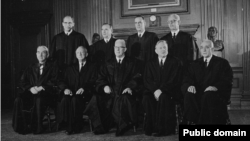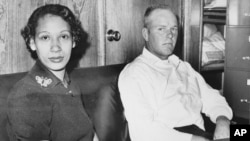In his draft opinion overturning the landmark Roe v. Wade ruling that legalized abortion, conservative U.S. Supreme Court Associate Justice Samuel Alito stressed that his ruling was limited to abortion and would not affect other rights.
“Nothing in this opinion,” Alito wrote in the leaked document, “should be understood to cast doubt on precedents that do not concern abortion.”
The document is an initial draft and could change before a final decision is handed down in the next several weeks. But despite Alito’s assurances, the sweeping case it makes for reversing the 1973 decision and a subsequent abortion ruling from 1992 has raised alarm among liberals that the same rationale could be used to roll back other rights.
Among them: the right of adults to use contraception, the freedom to marry outside one’s own race, and the right to same-sex marriage — freedoms known collectively as “substantive due process rights.”
“If the rationale of the decision as released were to be sustained, a whole range of rights are in question, a whole range of rights,” President Joe Biden said last week.
Central to Alito’s argument is an old conservative objection that Roe v. Wade “manufactured” a right that has no basis in the Constitution.
In affirming the right of Norma McCorvey — the Jane Roe in the court case — to end her pregnancy, the justices ruled 7-2 that abortion is part of a “fundamental right to privacy” inherent in the Constitution’s 14th Amendment.
Adopted in 1868, the 14th Amendment’s Due Process Clause has been used by the Supreme Court to affirm a panoply of constitutional rights such as the right to marry and the right to use contraception.
But Alito argued that neither abortion nor privacy can be found in the Constitution.
Echoing another conservative criticism, he wrote that the 1973 ruling was “egregiously wrong” in part because the right to an abortion is “not deeply rooted in the nation’s history and traditions.”
In fact, he noted, abortion was criminalized by many states at the time of the 14th Amendment’s ratification after the American Civil War.
But just because something was illegal in the 19th century and is not explicitly mentioned in the Constitution doesn’t mean it can’t be constitutionally protected, said Sonia Suter, a law professor at The George Washington University Law School.
“When you look at the way he does the analysis to say how terribly wrongly decided Roe was, you could use that exact same analysis to determine that there are aren’t other rights that are not explicitly mentioned in the Constitution,” Suter told VOA in an interview.
Caroline Fredrickson, a law professor at Georgetown University and a senior fellow at the left-leaning Brennan Center, said Alito’s assurance that his ruling would have no bearing on other precedents is “misleading.”
“It just doesn’t work that way,” she said in an interview with VOA. “Anybody who is familiar with the common law system understands that precedents are based on legal reasoning, and they develop. One precedent follows another. If you strike down a law based on a fundamental disagreement with the legal reasoning that underpins it, the same exact arguments will allow the other decisions to be overturned.”
Here is a look at four Supreme Court decisions that a Roe v. Wade reversal could impact.
Griswold v. Connecticut
Widely seen as a precursor to Roe v. Wade, this 1965 ruling struck down a Connecticut law that banned the use of contraception.
In 1961, Estelle Griswold, a Planned Parenthood official, and C. Lee Buxton, a Yale University gynecologist, were arrested and fined for operating a birth control clinic in Connecticut.
The two challenged their conviction, arguing that the Connecticut law violated their rights under the 14th Amendment.
In a 7-2 ruling, the court found Connecticut’s law infringed on the constitutional “right of marital privacy.”
The decision paved the way for Roe v. Wade, according to Suter.
“Roe relied heavily on the line of reasoning (in Griswold) and the sort of substantive due process,” she said.
If the Supreme Court overturns Roe, many liberals fear it could use the same reasoning to invalidate Roe’s precursor.
“If Casey (the 1992 opinion that reaffirmed abortion rights) is to fall, if Roe v. Wade is to fall, then Griswold v. Connecticut presumably is to fall, as well,” Democratic Representative Jamie Raskin, a constitutional scholar, said last week on MSNBC.
But while many conservatives have raised questions about the legal reasoning behind the contraception ruling, few expect an outright ban on birth control.
Instead, Fredrickson said, overturning Roe could lead to “a chipping away (of the right to contraception) by increasingly describing forms of birth control as abortion or ‘abortion-like’ and allowing states to regulate access to them.”
Loving v. Virginia
Before this 1967 case, more than a dozen U.S. states prohibited white people from marrying African Americans.
This historic case involved Mildred Jeter, a Black woman, and Richard Loving, a white man. Unable to marry in their own state in 1958, they traveled to Washington, D.C.
They were arrested when they returned to Virginia under the state’s laws banning interracial marriages.
Tried and convicted, they were each given a one-year jail sentence on the condition that they leave the state and not return as a married couple for 25 years.
The Supreme Court found that Virginia’s so-called anti-miscegenation statute violated the Equal Protection Clause of the 14th Amendment.
“Under our Constitution, the freedom to marry, or not marry, a person of another race resides within the individual and cannot be infringed by the state,” Chief Justice Earl Warren wrote in the court’s unanimous decision.
“Going after Loving would be extreme,” Fredrickson said.
Associate Justice Clarence Thomas, considered the court’s most conservative member, is an African American and married to a white woman.
Lawrence v. Texas
A landmark ruling for gay rights, this 2003 decision struck down a Texas law that criminalized homosexual sex, leading to the repeal of so-called “anti-sodomy laws” around the country.
In 1998, John Lawrence and a male partner were found having sex when police entered Lawrence’s apartment in response to a disturbance call.
After being arrested and fined under Texas’ anti-sodomy law, the men challenged the statute as a violation of the Equal Protection Clause.
The Supreme Court agreed. Associate Justice Anthony Kennedy, a prominent champion of LGBTQ rights on the court, wrote the majority opinion.
“Petitioners’ right to liberty under the Due Process Clause gives them the full right to engage in private conduct without government intervention,” he wrote.
For LGBTQ rights activists, the decision, which overturned a 1986 Supreme Court ruling upholding a similar anti-sodomy law in Georgia, was a major victory.
Obergefell v. Hodges
This 2015 decision established gay marriage as a constitutional right.
The case was brought by a group of same-sex couples challenging state laws that did not allow them to legally marry.
In a 5-4 decision, the Supreme Court ruled that states must allow gay couples to marry and recognize such marriages performed in states where they were legal.
Again, Kennedy wrote the majority opinion. “They ask for equal dignity in the eyes of the law. The Constitution grants them that right.”
Hailed as a major achievement for the LGBTQ community in America, the narrowly decided case is now in jeopardy, Fredrickson said.
“I think there is a very fervent disagreement with the Obergefell decision based on the same idea of tradition in our society,” he said.
All six conservatives currently on the bench disagree with the Obergefell ruling, according to legal scholars. But whether they’d join forces to overturn it “is another story,” Suter said.




